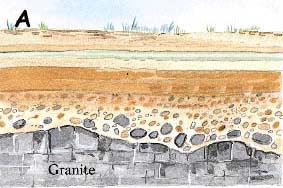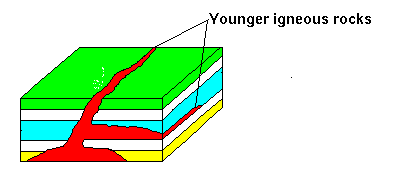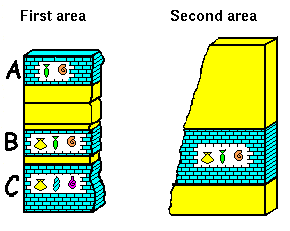
Relative age dating
Geologists use several basic laws for determining relative age relationships between bodies of rock.
Law of Original Horizontality - Sedimentary layers (strata) and lava flows were originally deposited as relatively horizontal sheets, like layers in a layer-cake. If they are no longer horizontal or flat, it is because they have been moved since they were originally deposited.
Law of Lateral Continuity - Lava flows and sedimentary rock units extend laterally in all directions until they thin to nothing or reach the edge of the basin of deposition.
Law of Superposition - In an undisturbed sequence of strata or lava flows, the oldest is at the bottom of the sequence and the youngest is at the top.
Practice:
Which is the oldest rock unit in the sequence below?
FIGURE 1

Law of Inclusions - Any piece of rock (clast) that has become included in another rock or body of sediment must be older than the rock or sediment into which is has been incorporated. The piece of rock is often call an inclusion.

Practice
Study the following two figures. By using the law of inclusions you should be able to determine the age relations between the granite and sedimentary rocks.
FIGURE 2


Law of Cross-Cutting relations - Any feature that cuts across a rock or body of sediment must be younger than the rock or sediment that it cuts across. Such cross-cutting features include fractures, faults, or masses of magma that cut across preexisting rocks before they cooled.

Practice:
Study the following figure. You should be able to determine the age relationship between the three rock units shown. Note: the thin shaded area adjacent to the contacts of units B and C are contact metamorphic rocks in the surrounding adjacent rocks. These are telling you that the rocks adjacent to these units were "cooked" and metamorphosed which means both units B and C are intrusions.
FIGURE 3

Fossil succession - Geologists have studied undisturbed sedimentary rocks at thousands of locations worldwide. They see a clear pattern of relative ordering of species through time. All extremely ancient species were sea-dwelling single-celled organisms. then fossil arthropods and fish appear in the rock layers, followed by fossil amphibians and then reptiles and then dinosaur fossils. From these patterns it is clear that species succeed one another in a regular pattern, so their fossils allow geologists to use the principle of fossil succession to determine their relative age.
Practice:
Lets assume you went and studied the geology at some location and found the following sequence of rocks and fossils in the rocks. You then went to a second area and found only one rock layer which you were able to identify fossils. Can you determine which of the three (A, B, or C) rock units from the first area corresponds to the unit you found in the second area?
FIGURE 4

|
|
Back to previous page |
Next page |
|